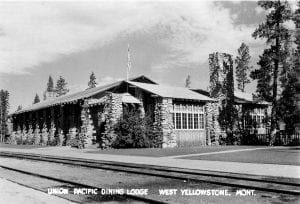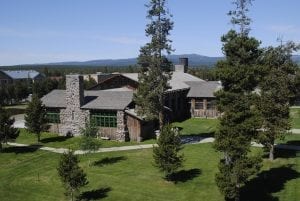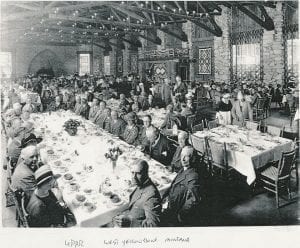 When the trains carrying tourists began to arrive in West Yellowstone it quickly became apparent to the Union Pacific officials that there needed to be a place close to the depot where the arriving guests could relax and grab a bite to eat either before touring Yellowstone or after their return.
When the trains carrying tourists began to arrive in West Yellowstone it quickly became apparent to the Union Pacific officials that there needed to be a place close to the depot where the arriving guests could relax and grab a bite to eat either before touring Yellowstone or after their return.
In 1908 the first eating establishment known as “The Beanery” was constructed. It was approximately 1000 feet west of the depot and housed the kitchen and serving area.
By 1920 tourism by train had grown to the point where the railroad realized they needed better accommodations and schedules for serving meals to the tourists. They constructed a Rest Pavilion in 1922 where visitors could wait until they were called for the “second seating” in the Beanery. This structure was located between the Beanery and the depot. It was made of logs and shingles and was open-sided. They railroad also attempted to stagger the arrival of trains into West Yellowstone so more people could be served at the restaurant. They hoped that by staggering the arrival times of the trains it would alleviate the problem of more people arriving at one time than the Beanery could accommodate. Unfortunately, this did not work out as well as they had hoped it would.
 The Union Pacific officials then proceeded with plans to construct a restaurant that could serve up to 350 guests in one seating. In 1925, they hired architect Gilbert Stanley Underwood to design their new dining facility. He worked with Daniel Hull, a planner and designer, and they were instrumental in developing the National Park’s “Rustic Architecture” style. That is a style that uses native materials in proper scale, avoiding rigid, straight lines, and giving the feeling of having been crafted by pioneer men with limited tools. These buildings were designed to have a connection to their natural surroundings and the past.
The Union Pacific officials then proceeded with plans to construct a restaurant that could serve up to 350 guests in one seating. In 1925, they hired architect Gilbert Stanley Underwood to design their new dining facility. He worked with Daniel Hull, a planner and designer, and they were instrumental in developing the National Park’s “Rustic Architecture” style. That is a style that uses native materials in proper scale, avoiding rigid, straight lines, and giving the feeling of having been crafted by pioneer men with limited tools. These buildings were designed to have a connection to their natural surroundings and the past.
The new Dining Lodge was completed in the fall of 1925 and was put into service at the beginning of the 1926 season. They incorporated the Rest Pavilion which became the Firehole Room at the East end of the lodge. This also served as the lounge area. The dining hall was a large central seating space known as the Mammoth Room. There was a massive, arrowhead-shaped fireplace, a kitchen where over 1,000 meals a day could be prepared. It also boasted a large service wing which contained the employee dining hall, a bakery, butcher shop, scullery, linen room, coal room, manager’s office and walk-in refrigerators and freezers.
 The exterior of the building was left virtually untouched until 1936 when new entrance doors replaced the windows at the North end of the Firehole Room. This provided direct access for tourists arriving street-side from the train stations in Gallatin Gateway or Bozeman. They came to West Yellowstone by means of a bus from the Chicago Milwaukee & St. Paul Railway depots.
The exterior of the building was left virtually untouched until 1936 when new entrance doors replaced the windows at the North end of the Firehole Room. This provided direct access for tourists arriving street-side from the train stations in Gallatin Gateway or Bozeman. They came to West Yellowstone by means of a bus from the Chicago Milwaukee & St. Paul Railway depots.
Minor damage was sustained by the Lodge during the 1959 earthquake. Most of the damage was to the rock work around the fireplace and the chimney at the West end of the building.
After the closure of dining service in 1960, major modifications were made to the interior of the service wing. Part of it is still a kitchen and the remainder of this part houses public restrooms, government offices and the Yellowstone Historic Center’s main office.
In 2008 major renovations were made to the Lodge after the town received a $400,000 grant through the Save America’s Treasures program and the town raised matching funds through a bond passed by the residents of the town. The main part of the building was re-shingled and electric service was upgraded.
In modern day times, the Dining Hall is used as a sort of convention center. It is the site of meetings, weddings and other special events.
AUTHOR: Sue Knapp